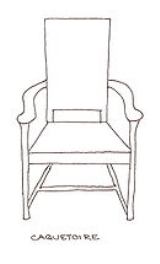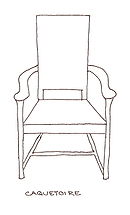
Caquetoire
Encyclopedia

Chair
A chair is a stable, raised surface used to sit on, commonly for use by one person. Chairs are most often supported by four legs and have a back; however, a chair can have three legs or could have a different shape depending on the criteria of the chair specifications. A chair without a back or...
, was an armchair style implemented during the European Renaissance.
It was largely used in France
France
The French Republic , The French Republic , The French Republic , (commonly known as France , is a unitary semi-presidential republic in Western Europe with several overseas territories and islands located on other continents and in the Indian, Pacific, and Atlantic oceans. Metropolitan France...
during the renaissance
Renaissance
The Renaissance was a cultural movement that spanned roughly the 14th to the 17th century, beginning in Italy in the Late Middle Ages and later spreading to the rest of Europe. The term is also used more loosely to refer to the historical era, but since the changes of the Renaissance were not...
. This chair is one if the most well known pieces of furniture from the French Renaissance. This chair is often associated with groups of women that would sit in them and talk. The seat is not rectangular like most. Due to the lack of heating systems in homes, women tended to wear several layers of skirts and petticoats to keep warm. This often inhibited them from fitting into normally-proportioned armchairs. Thus, the seat is splayed so the women could easily sit in the chair with their large skirts. These chairs were also made from walnut
Walnut
Juglans is a plant genus of the family Juglandaceae, the seeds of which are known as walnuts. They are deciduous trees, 10–40 meters tall , with pinnate leaves 200–900 millimetres long , with 5–25 leaflets; the shoots have chambered pith, a character shared with the wingnuts , but not the hickories...
not oak
Oak
An oak is a tree or shrub in the genus Quercus , of which about 600 species exist. "Oak" may also appear in the names of species in related genera, notably Lithocarpus...
because the chair could be more elaborately carved.
This chair also used mortise and tenon
Mortise and tenon
The mortise and tenon joint has been used for thousands of years by woodworkers around the world to join pieces of wood, mainly when the adjoining pieces connect at an angle of 90°. In its basic form it is both simple and strong. Although there are many joint variations, the basic mortise and tenon...
joint. In this joint, one end fits into the slot of the other end. This technique was used in the chair so no nails were exposed and so no glue had to be used.
The caquetoire is built with a splayed seat base and U-shaped arms to allow women with full skirts to sit comfortably. During the European Renaissance they were generally made of walnut
Walnut
Juglans is a plant genus of the family Juglandaceae, the seeds of which are known as walnuts. They are deciduous trees, 10–40 meters tall , with pinnate leaves 200–900 millimetres long , with 5–25 leaflets; the shoots have chambered pith, a character shared with the wingnuts , but not the hickories...
with mortise-and-tenon joints. The supports were baluster-turned and terminated in bun feet.
The name caquetoire is derived from “caqueter”, a French term meaning “to chat”. The chair was thus named the caquetoire as a reference to women sitting and talking.

